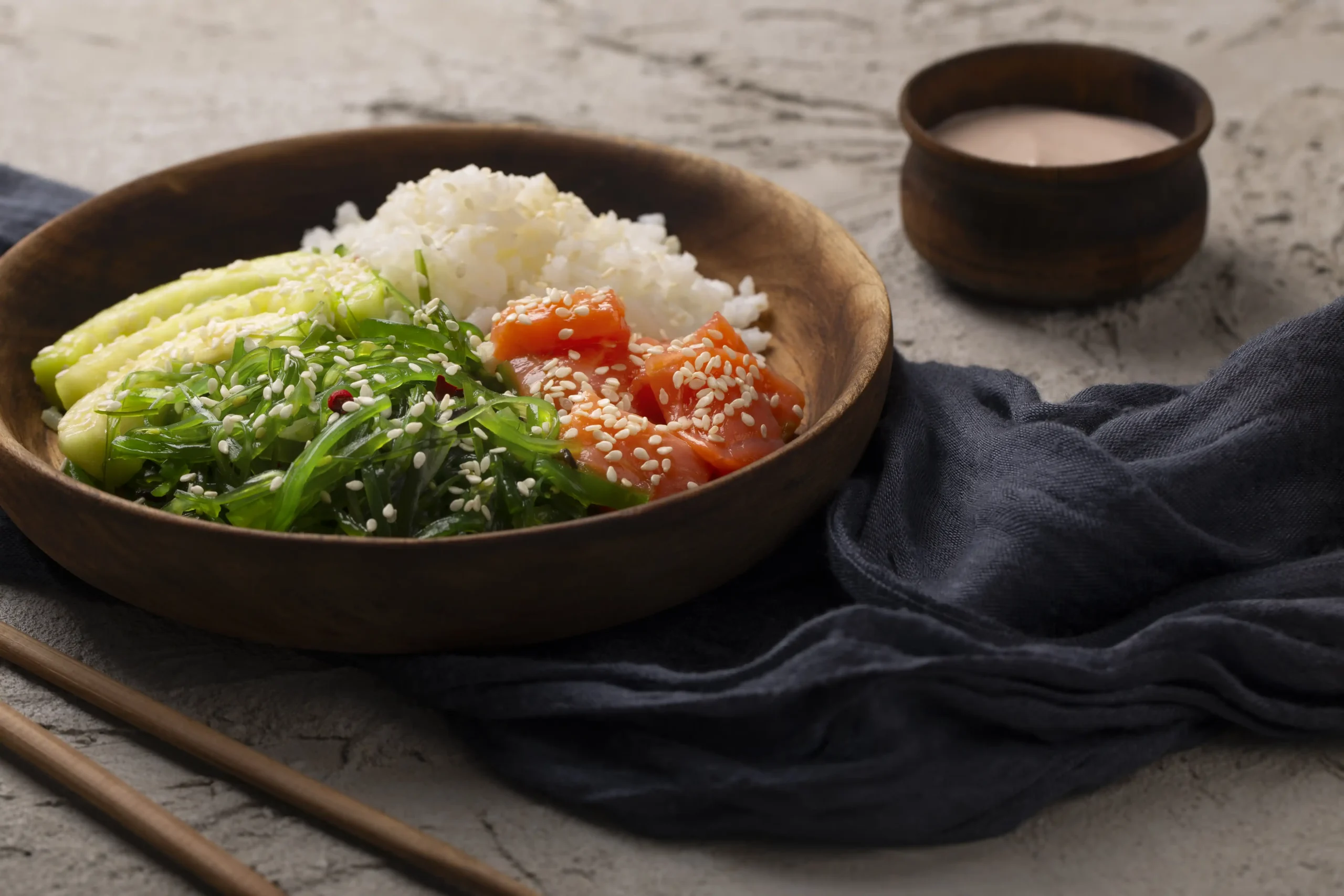Have you ever craved a lunch that’s both comforting and packed with bold, satisfying flavors—without relying on meat or complicated prep? That’s exactly what makes a vegetarian Korean lunch so irresistible. With its vibrant veggies, rich sauces like gochujang, and plant-based proteins like tofu, this style of cooking transforms everyday ingredients into something truly crave-worthy.
Whether you’re looking for a nourishing midday meal, prepping for the week, or just trying something new, Korean cuisine offers plenty of delicious, meat-free options that are anything but boring. In today’s recipe, we’ll keep things simple, wholesome, and deeply satisfying—perfect for anyone who wants to enjoy the heart of Korean food without the pork or alcohol.
Ready to dig into something that’s as easy as it is delicious? Let’s get started!
Table of Contents
🥢 Key Benefits of a Vegetarian Korean Lunch
Let’s talk about why a vegetarian Korean lunch isn’t just delicious—it’s a total win for your taste buds and your body. Whether you’re exploring plant-based eating or just want to switch up your lunch routine, Korean cuisine delivers big flavor in the most comforting way.
Here’s why this style of lunch deserves a spot in your weekly lineup:
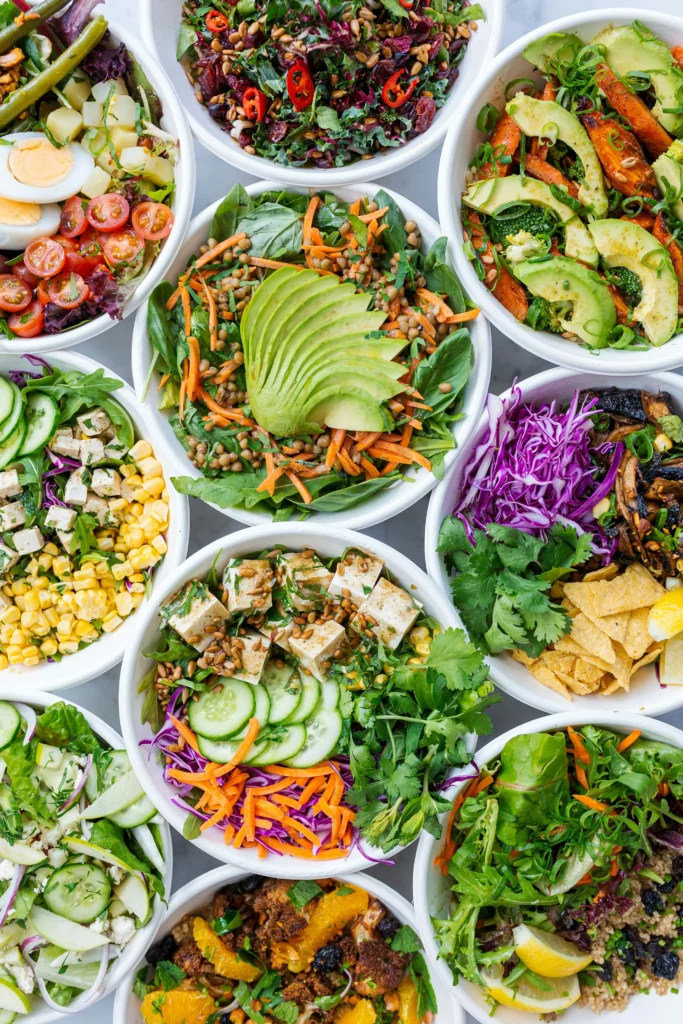
✅ 1. Wholesome and Nourishing
Korean vegetarian dishes are naturally packed with:
- Fresh vegetables like spinach, carrots, and zucchini
- Protein-rich ingredients like tofu, mushrooms, and soybean paste
- Fermented foods like vegan kimchi, which promote gut health
It’s the kind of lunch that fills you up without weighing you down.
✅ 2. Big Flavor, No Meat Needed
Think you need pork or beef for bold flavor? Not here.
Thanks to gochujang (a Korean chili paste), toasted sesame oil, garlic, and soy sauce, each bite bursts with:
- Spicy-sweet depth
- Earthy richness
- That addictive umami you’ll want again tomorrow
✅ 3. Easy to Prepare & Meal Prep Friendly
No need for a full kitchen setup or hours of prep.
- Most vegetarian Korean recipes come together in under 30 minutes.
- Dishes like bibimbap and japchae reheat beautifully, making them ideal for lunchboxes or meal prep.
- You can mix and match your favorite ingredients to create endless variations.
✅ 4. Naturally Balanced Nutrition
Korean lunch bowls are beautifully balanced:
- Complex carbs (like short-grain rice or sweet potato noodles)
- Healthy fats from sesame oil and seeds
- Plant protein from tofu or legumes
- Fiber and micronutrients from a rainbow of vegetables
✅ 5. Inclusive & Customizable
Whether you’re vegan, gluten-free, or just picky about textures, Korean vegetarian dishes are easy to tailor:
- Skip the gochujang if you’re sensitive to spice
- Use tamari instead of soy sauce for gluten-free
- Swap in seasonal veggies or whatever’s in your fridge
So, if you’ve been looking for a fresh take on lunch that’s comforting, energizing, and totally satisfying, you’re in the right place. A vegetarian Korean lunch is more than just a meal—it’s a delicious pause in your day that feels as good as it tastes.
🍴 Ingredients
Now that you know why a vegetarian Korean lunch is such a game-changer, let’s dive into what you’ll need to bring it to life. The best part? These ingredients are easy to find at most grocery stores, and the dish itself comes together quickly—perfect for busy days. Here’s what you’ll need for a simple, flavor-packed vegetarian Korean lunch:
Base
- Rice: Short-grain white rice (or brown rice if you prefer a heartier option) forms the base of many Korean lunches. It’s sticky, comforting, and absorbs the flavors beautifully.
- Noodles: If you’re in the mood for something different, sweet potato noodles (often used in japchae) are a great gluten-free alternative. They add a chewy texture that’s both satisfying and unique.
Protein
- Tofu: Firm tofu is a fantastic plant-based protein. When crisped up in a hot pan, it provides a nice texture that soaks up all the delicious flavors around it.
- Mushrooms: If you’re not a tofu fan, you can use shiitake or oyster mushrooms for a meaty, umami-packed alternative.
- Kimchi: For an authentic touch, add some vegan kimchi—a Korean staple that adds a zesty, fermented kick (and tons of probiotics!).
Vegetables
- Spinach: Lightly sautéed or blanched spinach is a common banchan (side dish) that pairs beautifully with your main.
- Carrots: Julienned carrots add a crisp, refreshing crunch to your dish.
- Zucchini: Thinly sliced zucchini adds mild flavor and texture.
- Bean Sprouts: For some extra crunch, bean sprouts are often used in Korean lunches, bringing a light and fresh element to balance the richness of the other ingredients.
Sauces & Seasoning
- Gochujang: This Korean chili paste adds the perfect balance of spicy and sweet. If you’re sensitive to heat, feel free to adjust the amount you use.
- Soy Sauce: A splash of soy sauce brings that savory, salty depth that ties everything together. If you’re avoiding gluten, you can swap this out with tamari.
- Sesame Oil: A drizzle of sesame oil adds a nutty aroma that elevates the dish.
- Garlic: Fresh garlic will bring an aromatic base to your stir-fried veggies or tofu.
- Sesame Seeds: A sprinkle of toasted sesame seeds not only adds crunch but also enhances the nutty flavors of the sesame oil.
Garnishes
- Scallions: Thinly sliced scallions (green onions) add freshness and a mild onion flavor.
- Perilla Leaves: These optional leaves add a unique, slightly minty taste that’s perfect for wrapping or layering on top of the dish.
🔪 Instructions
Ready to bring your vegetarian Korean lunch to life? Let’s get started! These steps are straightforward and easy to follow—perfect for busy days when you still want something hearty and flavorful.
1. Cook the Rice or Noodles
Start by cooking your rice or noodles. If you’re using rice, rinse it thoroughly until the water runs clear. This helps remove excess starch, giving you that perfect, sticky texture. Cook it according to package instructions. For noodles, follow the instructions for sweet potato noodles (if using), or cook your regular noodles until al dente. Set both aside to keep warm.
2. Sauté the Vegetables
In a large pan or wok, heat a little sesame oil over medium-high heat. Add the garlic and sauté until fragrant (about 30 seconds).
Next, toss in the carrots, zucchini, and bean sprouts. Stir-fry for 3-4 minutes until they’re just tender but still crisp. You want to preserve their bright colors and freshness. Once done, remove from the pan and set aside.
3. Cook the Tofu (or Mushrooms)
In the same pan, add a little more sesame oil and heat over medium-high. Cut the tofu into cubes or slices and add it to the pan. Let it cook, undisturbed, for 3-4 minutes on each side until it becomes golden brown and crispy. If you’re using mushrooms, slice them and cook them in the same way, allowing them to brown slightly to bring out their earthy flavor.
4. Assemble the Dish
Now that everything is cooked, it’s time to assemble! On a large plate or bowl, start with a scoop of rice or noodles.
Top with your sautéed vegetables and crispy tofu or mushrooms. Add a dollop of gochujang and drizzle with soy sauce or tamari. Garnish with scallions, perilla leaves, and a sprinkle of sesame seeds. For an extra pop of flavor, serve with a side of vegan kimchi.
🔥 Pro Tips and Variations
- Time-Saver Tip: Prep your veggies and tofu the night before to make this lunch even quicker to assemble.
- Swap Ideas: If you don’t have gochujang, try using sriracha mixed with a bit of honey for a quick spicy-sweet sauce.
- Vegan Options: If you’re following a vegan diet, just make sure your kimchi is free from fish sauce, and swap in tamari for soy sauce.
- Add More Protein: For even more protein, toss in some edamame, chickpeas, or tempeh along with the tofu.
With these simple, flavorful steps, you’ll have a vegetarian Korean lunch that’s as satisfying as it is nourishing. Whether you’re looking to mix up your regular lunch routine or prep meals for the week, this dish will quickly become your go-to for a comforting, balanced, and delicious meal.
🍽️ Serving Suggestions
Now that your vegetarian Korean lunch is ready, let’s talk about how to serve it to make the most of all those vibrant flavors. Korean cuisine is all about balance, so here are a few ways to elevate your meal:
1. Korean Lunch Bowl
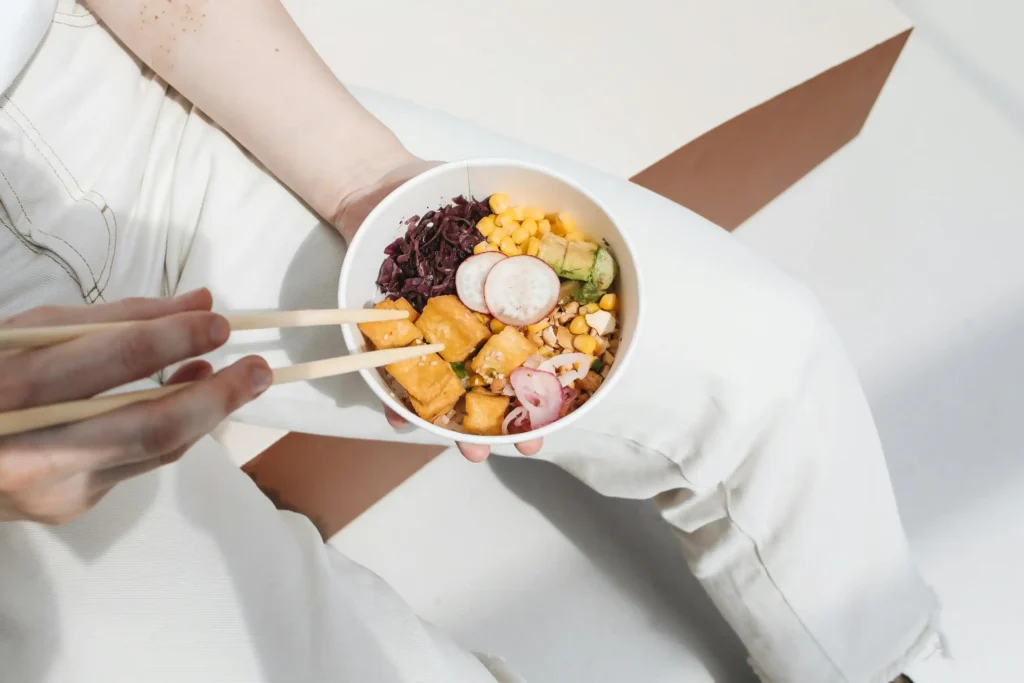
For a classic, comforting presentation, serve everything in a bowl. This allows the ingredients to mingle and the rice to soak up all the savory sauce and toppings. If you’re making bibimbap-style, don’t forget to add a fried egg on top for extra richness (if you’re not strictly vegan).
2. Bento Box Style
If you’re packing this for lunch or meal prep, go for a bento box style. Layer the rice, protein, and veggies separately in each compartment. This helps keep everything fresh and allows for easy reheating. Add some pickled radish or other banchan (small side dishes) for variety.
3. Wraps or Lettuce Cups
Want to switch things up? Serve your vegetarian Korean lunch ingredients inside lettuce cups or perilla leaves. Simply wrap your rice, tofu, and vegetables in the leaves and enjoy a handheld version of the meal. It’s a fun, fresh way to enjoy your lunch while keeping it light.
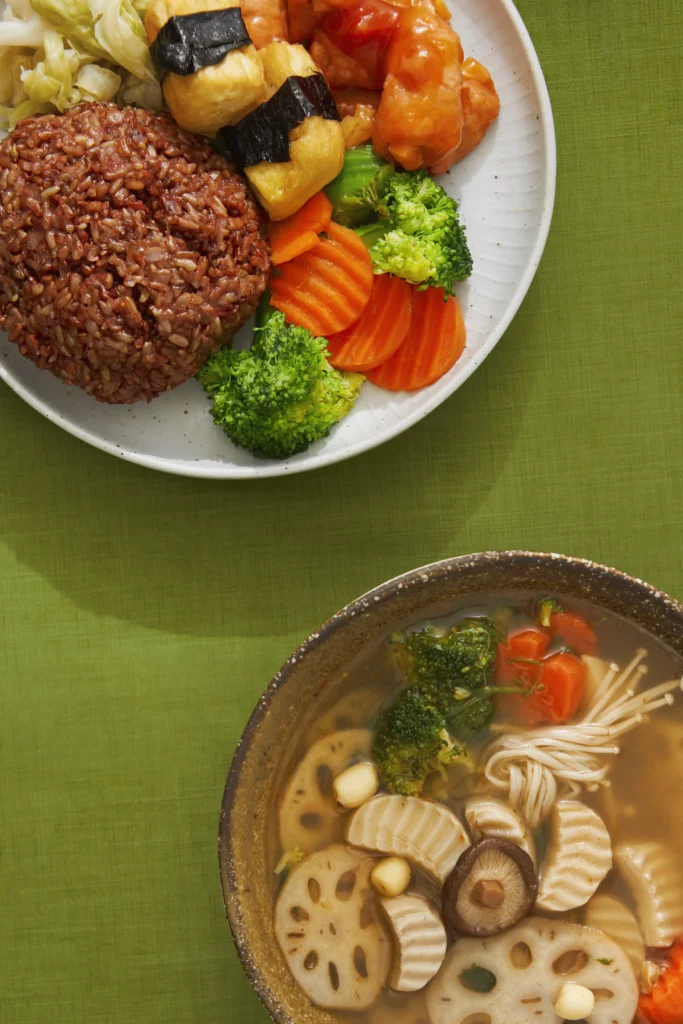
4. Side Dishes (Banchan)
In true Korean style, serve your main dish with some banchan (side dishes) like pickled radish, kimchi, or seasoned spinach. These sides add extra flavor and balance to the meal. You can prepare these in advance and store them in the fridge for easy access throughout the week.
✨ Conclusion
There’s something truly comforting about a vegetarian Korean lunch—it’s the kind of meal that not only satisfies your hunger but also nourishes your body. The flavors are bold yet balanced, with the perfect combination of spicy, savory, and fresh. Whether you’re craving something light yet filling or simply want to try something new, Korean vegetarian dishes have a way of hitting the spot.
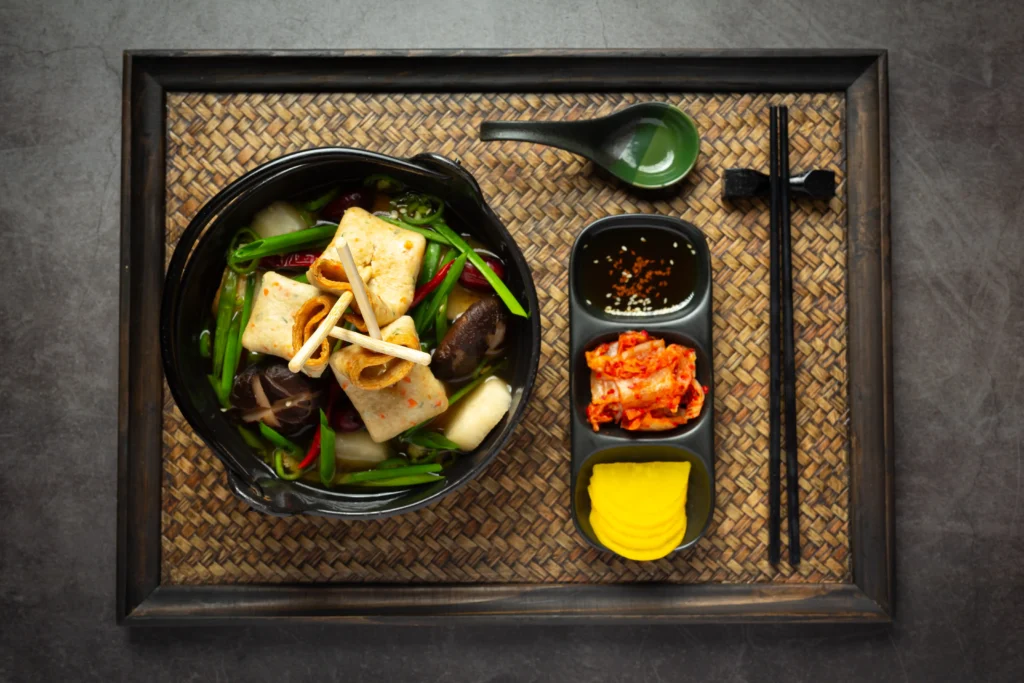
This recipe is a fantastic way to explore the richness of Korean cuisine without the meat. It’s versatile, easy to make, and packed with wholesome ingredients that leave you feeling energized. From the umami-packed tofu or mushrooms to the crunch of fresh vegetables and the kick of gochujang, every bite is full of flavor and texture that’ll keep you coming back for more.
Not only is it delicious, but it’s also highly customizable. You can switch up the vegetables, adjust the spice level to your liking, or even add your favorite plant-based protein. And because this meal is so balanced, it’s perfect for lunch, dinner, or even meal prepping for the week.
So, next time you’re in need of a comforting yet healthy meal, this vegetarian Korean lunch is the perfect choice. It’s simple, satisfying, and will quickly become a staple in your recipe rotation. Enjoy the process, savor every bite, and feel good knowing that you’re fueling your body with wholesome, delicious ingredients.
❓ FAQs
1. Can I make this vegetarian Korean lunch without gochujang?
Yes! If you’re not a fan of gochujang or prefer something milder, you can use a combination of sriracha and honey for a sweet-spicy kick or swap it out with a soy-based sauce for a less spicy option.
2. What can I use instead of tofu?
If tofu isn’t your thing, shiitake mushrooms, tempeh, or even chickpeas can make great alternatives. These provide the same hearty, protein-packed texture and absorb the flavors of the sauce just as well.
3. How do I make this recipe gluten-free?
To make it gluten-free, simply swap regular soy sauce for tamari, a gluten-free soy sauce alternative. Double-check that your gochujang and other condiments are also gluten-free, as some versions may contain wheat.
4. How long can I store leftovers?
Leftovers can be stored in an airtight container in the refrigerator for up to 3-4 days. For best results, store the rice or noodles and toppings separately to keep everything fresh. You can reheat it in the microwave or on the stovetop.
5. Can I add other vegetables to the dish?
Absolutely! Feel free to add broccoli, bell peppers, or spinach to the dish. Korean cuisine is all about variety, so don’t hesitate to experiment with whatever veggies you have on hand.
6. Is this recipe suitable for meal prep?
Yes, this dish is perfect for meal prep. You can prepare the rice, tofu, and vegetables in advance and store them separately. Just assemble your lunch the night before or in the morning, and you’ll have a fresh, nutritious meal ready to go!
7. What can I serve with this vegetarian Korean lunch?
For a true Korean experience, serve your lunch with vegan kimchi, pickled radish, or steamed dumplings. These small side dishes, known as banchan, add variety and a burst of flavor to your meal.
How was this recipe to you ?
There are no reviews yet. Be the first one to write one.

